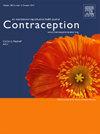CHANGES IN KNOWLEDGE OF ABORTION LEGALITY FOLLOWING DOBBS
IF 2.3
2区 医学
Q1 OBSTETRICS & GYNECOLOGY
引用次数: 0
Abstract
Objectives
We analyzed two independent waves of a population-representative survey of adult, reproductive-age women in Ohio to assess beliefs about legality of abortion and 11 other reproductive health practices in the state. Abortion was legal in Ohio until 22 weeks of gestation during both waves; however, during a brief period between waves, abortion was restricted to about 6 weeks of gestation.
Methods
We used logistic regression to compare the prevalence of believing abortion is illegal in Ohio pre-Dobbs (October 2018–June 2019; n=2,516) vs. post-Dobbs (September 2022–August 2023; n=2,421). We also measured beliefs about legality of 11 other practices post-Dobbs and identified correlates of holding these beliefs.
Results
Higher fractions of women believed that abortion was illegal in 2022-2023 compared to 2018-2019 (40.5% versus 10.1%, respectively; p<0.001). At both times, many reported not knowing the legal status (28.7% and 26.5%, respectively). Similarly, substantial percentages of women in 2022-2023 reported not knowing the legality of practices such as using assisted reproductive technology (17.3%), traveling out of state to obtain an abortion (44.3%), obtaining medical care during or after miscarriage (21.3%), or receiving care for ectopic pregnancy (27.7%). Women with higher socioeconomic status had higher odds of knowing abortion was legal in Ohio post-Dobbs.
Conclusions
Despite being legal, 40.5% of adult, reproductive-age women in Ohio in 2022-2023 believed abortion was illegal in the state, a large increase from pre-Dobbs. Rapid changes in state-level abortion laws following Dobbs could have caused confusion about the legality of abortion and introduced concerns about the legality of other reproductive health practices.
多布斯案之后堕胎合法性知识的变化
目标我们对俄亥俄州成年育龄妇女的两次独立的人口代表性调查进行了分析,以评估该州对堕胎合法性和其他 11 种生殖健康行为的看法。在这两次调查中,俄亥俄州的堕胎在妊娠 22 周前都是合法的;然而,在两次调查之间的短暂时期,堕胎被限制在妊娠 6 周左右。方法我们使用逻辑回归比较了认为俄亥俄州多布斯调查前(2018 年 10 月至 2019 年 6 月;n=2,516)与多布斯调查后(2022 年 9 月至 2023 年 8 月;n=2,421)堕胎非法的流行率。我们还测量了多布斯会议后对 11 种其他做法合法性的看法,并确定了持有这些看法的相关因素。结果与 2018-2019 年相比,2022-2023 年有更高比例的妇女认为堕胎是非法的(分别为 40.5% 对 10.1%;p<0.001)。在这两个时间段,许多人表示不知道法律地位(分别为 28.7% 和 26.5%)。同样,2022-2023 年有相当比例的妇女表示不知道使用辅助生殖技术(17.3%)、到州外堕胎(44.3%)、在流产期间或之后获得医疗护理(21.3%)或接受宫外孕护理(27.7%)等做法的合法性。结论尽管堕胎合法,但 2022-2023 年俄亥俄州仍有 40.5%的成年育龄妇女认为堕胎在该州是非法的,与多布斯案之前相比大幅增加。在多布斯案之后,州一级的堕胎法律发生了迅速变化,这可能会造成对堕胎合法性的混淆,并引发对其他生殖健康行为合法性的担忧。
本文章由计算机程序翻译,如有差异,请以英文原文为准。
求助全文
约1分钟内获得全文
求助全文
来源期刊

Contraception
医学-妇产科学
CiteScore
4.70
自引率
17.20%
发文量
211
审稿时长
69 days
期刊介绍:
Contraception has an open access mirror journal Contraception: X, sharing the same aims and scope, editorial team, submission system and rigorous peer review.
The journal Contraception wishes to advance reproductive health through the rapid publication of the best and most interesting new scholarship regarding contraception and related fields such as abortion. The journal welcomes manuscripts from investigators working in the laboratory, clinical and social sciences, as well as public health and health professions education.
 求助内容:
求助内容: 应助结果提醒方式:
应助结果提醒方式:


